1. Cheng LJ, Chen JH, Lin MY, Chen LC, Lao CH, Luh H, Hwang SJ. A competing risk analysis of sequential complication development in Asian type 2 diabetes mellitus patients. Sci Rep. 2015; 5:15687. PMID:
26507664.

2. Nicholas J, Charlton J, Dregan A, Gulliford MC. Recent HbA1c values and mortality risk in type 2 diabetes. Population-based case-control study. PLoS One. 2013; 8:e68008. PMID:
23861845.

3. Liu Z, Fu C, Wang W, Xu B. Prevalence of chronic complications of type 2 diabetes mellitus in outpatients: a cross-sectional hospital based survey in urban China. Health Qual Life Outcomes. 2010; 8:62. PMID:
20579389.

4. Hirakawa Y, Ninomiya T, Kiyohara Y, Murakami Y, Saitoh S, Nakagawa H, Okayama A, Tamakoshi A, Sakata K, Miura K, Ueshima H, Okamura T. Evidence for Cardiovascular Prevention From Observational Cohorts in Japan Research Group (EPOCH-JAPAN). Age-specific impact of diabetes mellitus on the risk of cardiovascular mortality: an overview from the evidence for Cardiovascular Prevention from Observational Cohorts in the Japan Research Group (EPOCH-JAPAN). J Epidemiol. 2017; 27:123–129. PMID:
28142033.

5. Salinero-Fort MA, San Andres-Rebollo FJ, de Burgos-Lunar C, Abanades-Herranz JC, Carrillo-de-Santa-Pau E, Chico-Moraleja RM, Jimenez-García R, Lopez-de-Andres A, Gomez-Campelo P. MADIABETES Group. Cardiovascular and all-cause mortality in patients with type 2 diabetes mellitus in the MADIABETES Cohort Study: association with chronic kidney disease. J Diabetes Complications. 2016; 30:227–236. PMID:
26627635.

6. Looker AC, Eberhardt MS, Saydah SH. Diabetes and fracture risk in older U.S. adults. Bone. 2016; 82:9–15. PMID:
25576672.

7. Nwaneri C, Bowen-Jones D, Cooper H, Chikkaveerappa K, Afolabi BA. Falling mortality rates in type 2 diabetes mellitus in the Wirral Peninsula: a longitudinal and retrospective cohort population-based study. Postgrad Med J. 2012; 88:679–683. PMID:
22904202.

8. Rawshani A, Svensson AM, Zethelius B, Eliasson B, Rosengren A, Gudbjornsdottir S. Association between socioeconomic status and mortality, cardiovascular disease, and cancer in patients with type 2 diabetes. JAMA Intern Med. 2016; 176:1146–1154. PMID:
27367969.

9. Liu L, Simon B, Shi J, Mallhi AK, Eisen HJ. Impact of diabetes mellitus on risk of cardiovascular disease and all-cause mortality: evidence on health outcomes and antidiabetic treatment in United States adults. World J Diabetes. 2016; 7:449–461. PMID:
27795819.

10. Ito WD, Lund N, Sager H, Becker W, Wenzel U. Differential impact of diabetes mellitus type II and arterial hypertension on collateral artery growth and concomitant macrophage accumulation. Vasa. 2015; 44:31–41. PMID:
25537056.

11. Balducci S, D'Errico V, Haxhi J, Sacchetti M, Orlando G, Cardelli P, Vitale M, Bollanti L, Conti F, Zanuso S, Nicolucci A, Pugliese G. Italian Diabetes and Exercise Study 2 (IDES_2) Investigators. Effect of a behavioral intervention strategy for adoption and maintenance of a physically active lifestyle: the Italian Diabetes and Exercise Study 2 (IDES_2): a randomized controlled trial. Diabetes Care. 2017; 40:1444–1452. PMID:
28821576.
12. Karthik D, Vijayakumar R, Pazhanichamy K, Ravikumar S. A proteomics approach to identify the differential protein level in cardiac muscle of diabetic rat. Acta Biochim Pol. 2014; 61:285–293. PMID:
24918489.

13. Wan EY, Fung CS, Fong DY, Lam CL. Association of variability in hemoglobin A1c with cardiovascular diseases and mortality in Chinese patients with type 2 diabetes mellitus: a retrospective population-based cohort study. J Diabetes Complications. 2016; 30:1240–1247. PMID:
27318537.
14. Samefors M, Scragg R, Lanne T, Nystrom FH, Ostgren CJ. Association between serum 25(OH)D(3) and cardiovascular morbidity and mortality in people with type 2 diabetes: a community-based cohort study. Diabet Med. 2017; 34:372–379. PMID:
27862247.
15. Ehrlich SF, Quesenberry CP Jr, Van Den Eeden SK, Shan J, Ferrara A. Patients diagnosed with diabetes are at increased risk for asthma, chronic obstructive pulmonary disease, pulmonary fibrosis, and pneumonia but not lung cancer. Diabetes Care. 2010; 33:55–60. PMID:
19808918.

16. Venmans LM, Bont J, Gorter KJ, Verheij TJ, Rutten GE, Hak E. Prediction of complicated lower respiratory tract infections in older patients with diabetes. Br J Gen Pract. 2008; 58:564–568. PMID:
18682019.

17. Colbay G, Cetin M, Colbay M, Berker D, Guler S. Type 2 diabetes affects sleep quality by disrupting the respiratory function. J Diabetes. 2015; 7:664–671. PMID:
25266369.

18. Klekotka RB, Mizgała E, Krol W. The etiology of lower respiratory tract infections in people with diabetes. Pneumonol Alergol Pol. 2015; 83:401–408. PMID:
26379004.

19. Lau D, Eurich DT, Majumdar SR, Katz A, Johnson JA. Effectiveness of influenza vaccination in working-age adults with diabetes: a population-based cohort study. Thorax. 2013; 68:658–663. PMID:
23535212.

20. American Diabetes Association. Immunization and the prevention of influenza and pneumococcal disease in people with diabetes. Diabetes Care. 2000; 23(Suppl 1):S91–S93. PMID:
12017693.
21. Lau D, Eurich DT, Majumdar SR, Katz A, Johnson JA. Working-age adults with diabetes experience greater susceptibility to seasonal influenza: a population-based cohort study. Diabetologia. 2014; 57:690–698. PMID:
24496923.

22. Rao Kondapally Seshasai S, Kaptoge S, Thompson A, Di Angelantonio E, Gao P, Sarwar N, Whincup PH, Mukamal KJ, Gillum RF, Holme I, Njolstad I, Fletcher A, Nilsson P, Lewington S, Collins R, Gudnason V, Thompson SG, Sattar N, Selvin E, Hu FB, Danesh J. Emerging Risk Factors Collaboration. Diabetes mellitus, fasting glucose, and risk of cause-specific death. N Engl J Med. 2011; 364:829–841. PMID:
21366474.

23. Di Yacovo S, Garcia-Vidal C, Viasus D, Adamuz J, Oriol I, Gili F, Vilarrasa N, García-Somoza MD, Dorca J, Carratala J. Clinical features, etiology, and outcomes of community-acquired pneumonia in patients with diabetes mellitus. Medicine (Baltimore). 2013; 92:42–50. PMID:
23263718.

24. Schneider ALC, Selvin E, Sharrett AR, Griswold M, Coresh J, Jack CR Jr, Knopman D, Mosley T, Gottesman RF. Diabetes, prediabetes, and brain volumes and subclinical cerebrovascular disease on MRI: the Atherosclerosis Risk in Communities Neurocognitive Study (ARIC-NCS). Diabetes Care. 2017; 40:1514–1521. PMID:
28916531.

25. Afkarian M, Sachs MC, Kestenbaum B, Hirsch IB, Tuttle KR, Himmelfarb J, de Boer IH. Kidney disease and increased mortality risk in type 2 diabetes. J Am Soc Nephrol. 2013; 24:302–308. PMID:
23362314.

26. Ohno K, Kuno A, Murase H, Muratsubaki S, Miki T, Tanno M, Yano T, Ishikawa S, Yamashita T, Miura T. Diabetes increases the susceptibility to acute kidney injury after myocardial infarction through augmented activation of renal Toll-like receptors in rats. Am J Physiol Heart Circ Physiol. 2017; 313:H1130–H1142. PMID:
28822965.

27. Graveling AJ, Frier BM. Driving and diabetes: problems, licensing restrictions and recommendations for safe driving. Clin Diabetes Endocrinol. 2015; 1:8. PMID:
28702227.

28. Harsch IA, Stocker S, Radespiel-Troger M, Hahn EG, Konturek PC, Ficker JH, Lohmann T. Traffic hypoglycaemias and accidents in patients with diabetes mellitus treated with different antidiabetic regimens. J Intern Med. 2002; 252:352–360. PMID:
12366608.

29. Lonnen KF, Powell RJ, Taylor D, Shore AC, MacLeod KM. Road traffic accidents and diabetes: insulin use does not determine risk. Diabet Med. 2008; 25:578–584. PMID:
18445171.

30. Renehan AG, Yeh HC, Johnson JA, Wild SH, Gale EA, Moller H;. Diabetes and cancer (2): evaluating the impact of diabetes on mortality in patients with cancer. Diabetologia. 2012; 55:1619–1632. PMID:
22476948.

31. Gu Y, Hou X, Zheng Y, Wang C, Zhang L, Li J, Huang Z, Han M, Bao Y, Zhong W, Jia W, Cui S. Incidence and mortality risks of cancer in patients with type 2 diabetes: a retrospective study in Shanghai, China. Int J Environ Res Public Health. 2016; 13:E559. PMID:
27271648.

32. Best LG, Garcia-Esquinas E, Yeh JL, Yeh F, Zhang Y, Lee ET, Howard BV, Farley JH, Welty TK, Rhoades DA, Rhoades ER, Umans JG, Navas-Acien A. Association of diabetes and cancer mortality in American Indians: the Strong Heart Study. Cancer Causes Control. 2015; 26:1551–1560. PMID:
26250516.

33. Pladys A, Couchoud C, LeGuillou A, Siebert M, Vigneau C, Bayat S. Type 1 and type 2 diabetes and cancer mortality in the 2002-2009 cohort of 39,811 French dialyzed patients. PLoS One. 2015; 10:e0125089. PMID:
25965806.
34. Charlot M, Castro-Webb N, Bethea TN, Bertrand K, Boggs DA, Denis GV, Adams-Campbell LL, Rosenberg L, Palmer JR. Diabetes and breast cancer mortality in Black women. Cancer Causes Control. 2017; 28:61–67. PMID:
27995352.

35. Luo J, Virnig B, Hendryx M, Wen S, Chelebowski R, Chen C, Rohan T, Tinker L, Wactawski-Wende J, Lessin L, Margolis K. Diabetes, diabetes treatment and breast cancer prognosis. Breast Cancer Res Treat. 2014; 148:153–162. PMID:
25261292.

36. Lee J, Giovannucci E, Jeon JY. Diabetes and mortality in patients with prostate cancer: a meta-analysis. Springerplus. 2016; 5:1548. PMID:
27652121.

37. Tan C, Mori M, Adachi Y, Wakai K, Suzuki S, Suzuki K, Hashimoto Sh, Watanabe Y, Tamakoshi A. Diabetes mellitus and risk of colorectal cancer mortality in Japan: the Japan Collaborative Cohort Study. Asian Pac J Cancer Prev. 2016; 17:4681–4688. PMID:
27892965.
38. Tsujimoto T, Kajio H, Sugiyama T. Favourable changes in mortality in people with diabetes: US NHANES 1999-2010. Diabetes Obes Metab. 2018; 20:85–93. PMID:
28640432.
39. Ben Assayag E, Eldor R, Korczyn AD, Kliper E, Shenhar-Tsarfaty S, Tene O, Molad J, Shapira I, Berliner S, Volfson V, Shopin L, Strauss Y, Hallevi H, Bornstein NM, Auriel E. Type 2 diabetes mellitus and impaired renal function are associated with brain alterations and poststroke cognitive decline. Stroke. 2017; 48:2368–2374. PMID:
28801477.

40. Kalaria RN. Neurodegenerative disease: diabetes, microvascular pathology and Alzheimer disease. Nat Rev Neurol. 2009; 5:305–306. PMID:
19498432.
41. Li J, Cesari M, Liu F, Dong B, Vellas B. Effects of diabetes mellitus on cognitive decline in patients with Alzheimer disease: a systematic review. Can J Diabetes. 2017; 41:114–119. PMID:
27614804.

42. Lu ZK, Li M, Yuan J, Wu J. The role of cerebrovascular disease and the association between diabetes mellitus and dementia among aged medicare beneficiaries. Int J Geriatr Psychiatry. 2016; 31:92–98. PMID:
25900428.

43. Dodge HH, Chang CC, Kamboh IM, Ganguli M. Risk of Alzheimer's disease incidence attributable to vascular disease in the population. Alzheimers Dement. 2011; 7:356–360. PMID:
21575878.

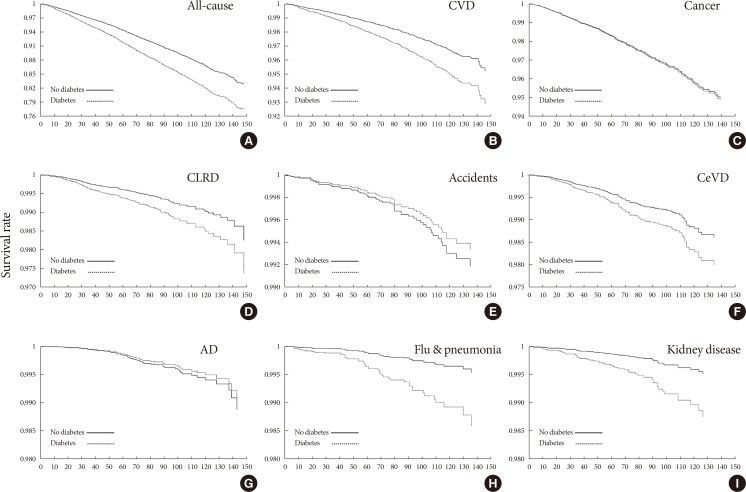
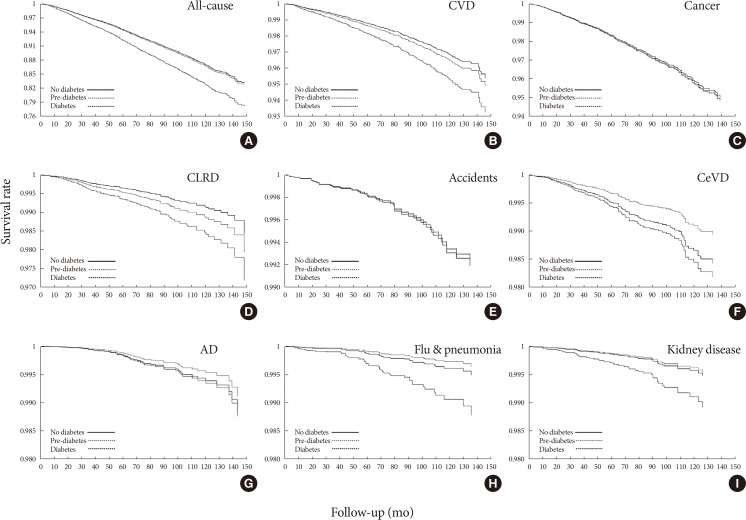
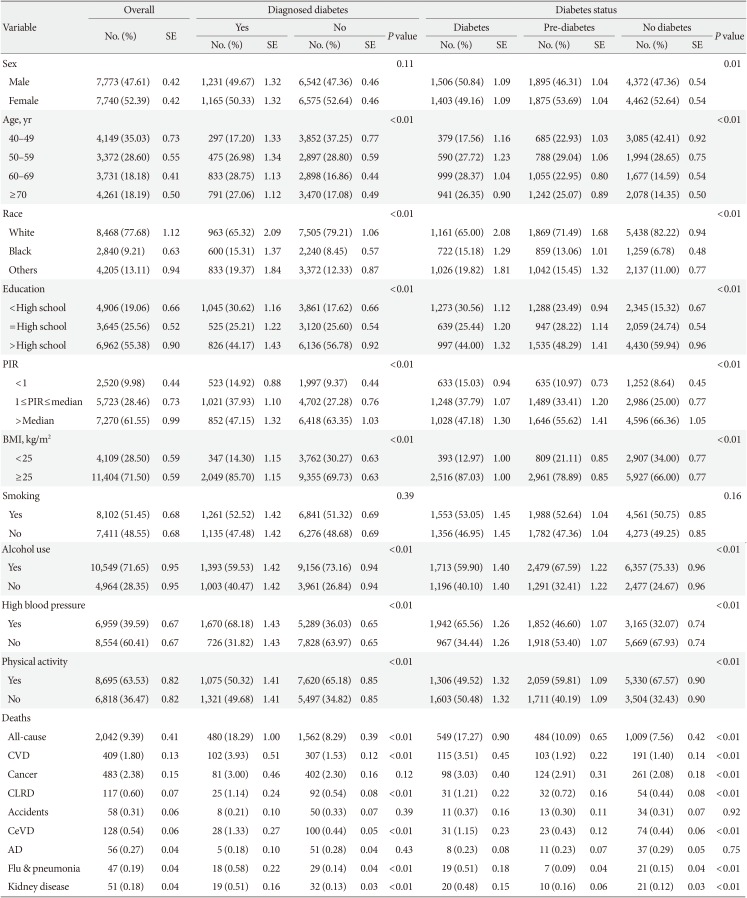
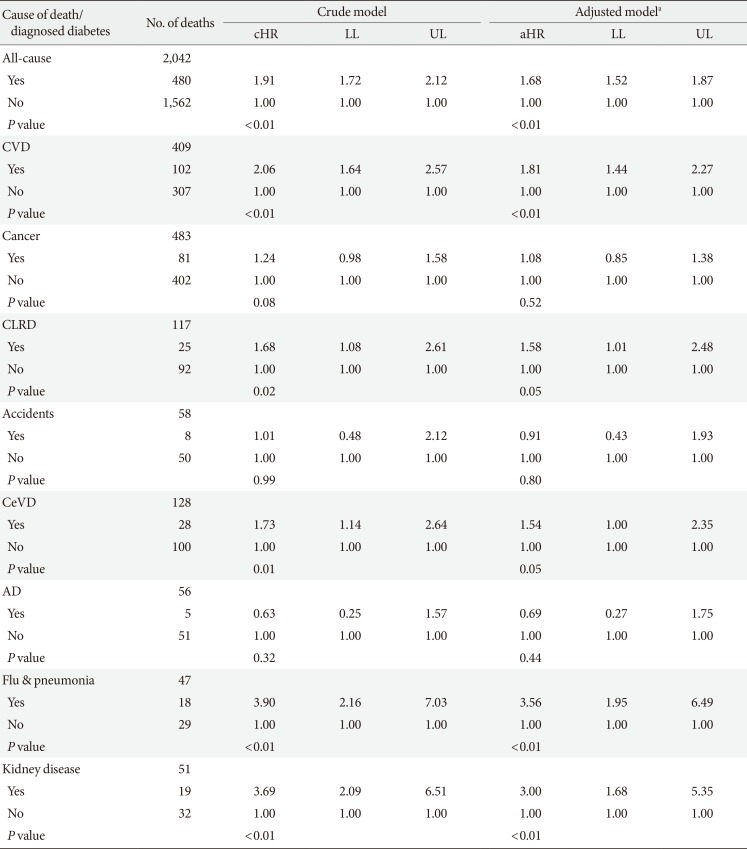
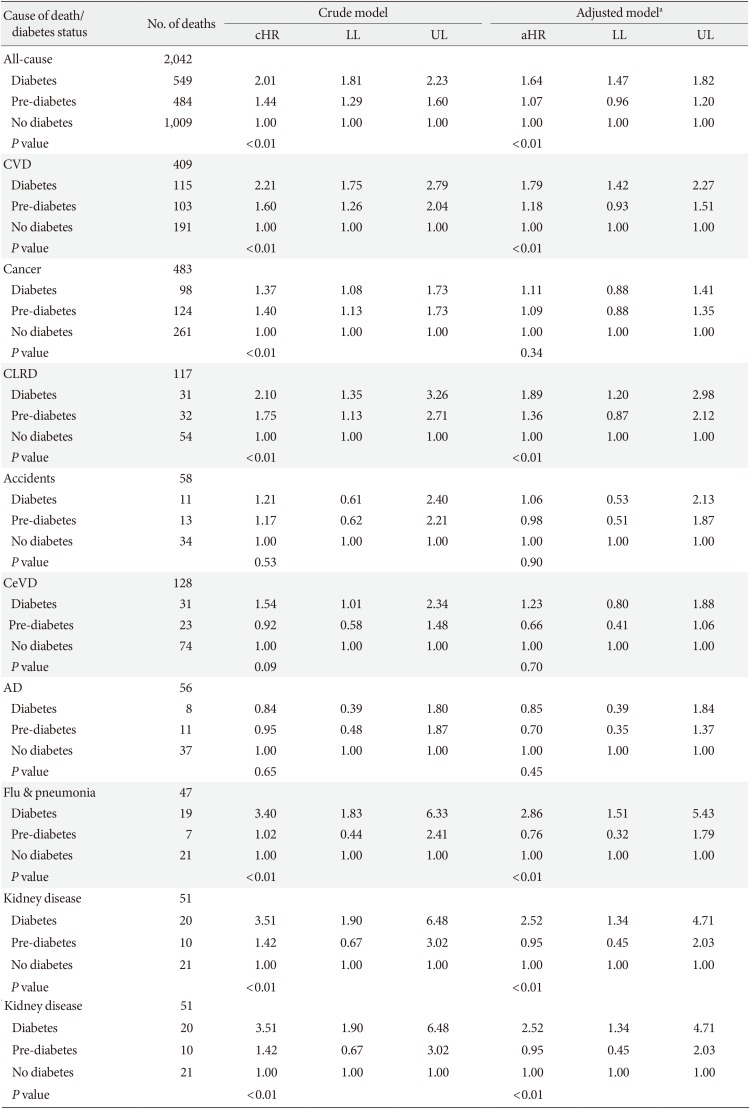




 PDF
PDF ePub
ePub Citation
Citation Print
Print



 XML Download
XML Download